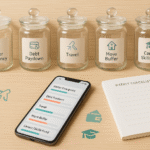The debt snowball method can be a powerful, motivating way to eliminate what you owe by paying off your smallest balances first and rolling each “win” into the next account. It’s simple, visual, and momentum-rich. But there are pitfalls that quietly slow you down, cost extra interest, or derail your plan altogether. This guide breaks down the five most common mistakes people make when using the debt snowball method—and shows you exactly how to avoid them, with step-by-step fixes, simple tools, metrics to track, and a 4-week starter plan.
Disclaimer: This article is for general education only. Debt and credit situations are personal. For advice tailored to your circumstances, consider consulting a qualified financial professional.
Key takeaways
- Start with stability. A basic budget and emergency buffer prevent “surprise” expenses from wrecking your snowball momentum.
- Pick a lane and stick with it. The snowball works when you actually pay smallest balance first while keeping all minimums current—no midstream reshuffles.
- Watch interest costs. Snowball can cost more than other methods if you ignore high-APR outliers; use a hybrid tweak without losing momentum.
- Don’t nuke your credit by accident. Closing paid-off cards or letting them go completely inactive can spike utilization and ding your score.
- Automate progress and guard the gains. Autopay, payment streaks, and a “debt firewall” for new spending protect the plan and speed results.
1) Starting Without a Budget and Emergency Buffer
What it is & why it matters
The snowball method focuses on behavior and momentum—but momentum stalls if every flat tire, medical copay, or forgotten bill forces you to swipe plastic again. Launching a snowball without a clear budget and a small emergency buffer often leads to “one step forward, two steps back.” A few unplanned expenses can rebuild balances you just eliminated.
Requirements & low-cost tools
- Budgeting tool: Spreadsheet, a free budgeting app, or a printable budget worksheet.
- Bill calendar: A simple monthly view with due dates to prevent late fees.
- Emergency buffer: Start small—even a few thousand (or less, if that’s what’s realistic) beats zero. The “right” amount varies by household; focus on getting something set aside quickly.
Step-by-step: how to implement
- Inventory your bills and due dates. List each debt, minimum payment, and due date. Add utilities, rent, insurance, and subscriptions.
- Build a starter buffer. Park an initial emergency reserve in a separate savings account. Begin with a small target that’s realistic for you—then grow it steadily.
- Create a simple zero-based budget. Allocate every unit of income on paper before the month starts. Prioritize essentials, minimum debt payments, your snowball extra, and a modest “true expenses” fund for irregular costs.
- Schedule automatic transfers. Send a fixed amount to emergency savings on payday, even if it’s modest.
- Open a bill calendar. Set reminders at least 3–5 days before each due date.
Beginner modifications & progressions
- If cash is tight: Start with a micro-buffer (e.g., one week’s expenses or the most common “surprise bill” in your life).
- Progression: After your first two debts are gone, redirect a slice of that freed-up payment to strengthen the emergency fund while keeping most of it on the snowball.
Recommended frequency, duration & metrics
- Weekly: 10-minute budget check-in.
- Monthly: Reconcile your spending, reset categories, update your snowball list.
- Metrics: Size of emergency buffer, on-time payment rate (goal: 100%), and variance vs. budget (keep surprises under a small threshold you set).
Safety, caveats & common errors
- Skipping the buffer completely risks putting emergencies on credit, undoing your progress.
- Relying on irregular income without a plan leads to missed minimums—track a rolling one-month cash forecast.
Mini-plan example (2–3 steps)
- This week: List every bill and due date in a single calendar.
- Payday: Auto-transfer a small fixed amount to a separate savings account and schedule all minimums.
- End of month: Reconcile, then set next month’s budget with a target to grow the buffer again.
2) Mixing Up the Order—or Mixing Methods—Midstream
What it is & why it matters
The snowball method pays the smallest balance first, regardless of interest rate, to produce fast wins and keep motivation high. The biggest mistake is abandoning that order whenever a balance “feels” expensive, or flip-flopping to a different method without a plan. That muddles your focus and extends the timeline.
Requirements & low-cost tools
- Sorted list of debts by balance: Smallest to largest, minimums noted.
- Simple tracker: Paper, spreadsheet, or app that can reorder debts and show payoff dates.
- Motivation cues: Visual progress bar, payment streak counter, or a printable checklist.
Step-by-step: how to implement
- List all debts from smallest to largest. Note APRs and minimum payments separately.
- Lock the order. Your target changes only when a smaller balance is paid in full.
- Roll the payment. When a debt hits zero, move that old payment to the next debt immediately—same day, same dollar amount.
- Review quarterly. Recalculate the payoff date and interest cost—but do not reorder unless you add or remove a debt.
Beginner modifications & progressions
- Beginner: Keep the list simple—no more than balances, minimums, and next target.
- Progression: After you’ve paid off the first two debts, add a small “interest rate check” (see mistake #3) to catch any high-APR outliers without fully abandoning snowball order.
Recommended frequency, duration & metrics
- Biweekly or monthly: Update balances.
- Metrics: Number of accounts remaining, payment streak length, and time to next payoff date.
Safety, caveats & common errors
- Missing minimums while over-funding the current target can trigger fees and damage your credit. Always schedule every minimum first.
- “This one annoys me” reshuffle: feelings are human, but reshuffling breaks momentum math. Keep the sequence intact and aim that emotion at the current target’s extra payments.
Mini-plan example
- Tonight: Sort debts by balance and highlight the smallest.
- Tomorrow: Schedule all minimums, then push every extra dollar to that smallest balance.
- Upon payoff: Auto-increase the next target’s payment by the same amount—no decision fatigue.
3) Ignoring Interest Costs (and High-APR Outliers)
What it is & why it matters
By design, the snowball deprioritizes interest rates to maximize motivation. That can be worth it. But completely ignoring very high interest can add substantial cost and extend your journey—especially if a high-APR card sits mid-list for months while interest compounds.
Requirements & low-cost tools
- “Hybrid check” once per quarter: A 15-minute review asking, “Is there a high-APR outlier worth moving up?”
- Negotiation plan: A short script to request rate reductions or fee waivers.
- 0% tools, used carefully: Balance-transfer offers or hardship programs (evaluate fees, promo periods, and your ability to pay off before the intro rate ends).
Step-by-step: how to implement
- Run a quarterly interest scan. Identify any debt whose APR is dramatically higher than the rest.
- Attempt cost reductions first. Call the issuer to request a lower rate, fee waiver, or hardship plan. Document the outcome.
- Consider a limited “hybrid” tweak. After your first one or two snowball wins, it’s reasonable to bump one glaring high-APR debt earlier in the sequence—once—if doing so significantly cuts interest and doesn’t destroy your momentum.
- Mind the fine print on 0% promos. Verify transfer fees, when the promo ends, and what your monthly payment must be to retire the balance within that window.
Beginner modifications & progressions
- Beginner: Keep pure snowball for your first one or two wins to lock in habits.
- Progression: Adopt a “snowball-plus” approach—smallest first, with a one-time re-rank for a single high-APR outlier after you’ve proven consistency.
Recommended frequency, duration & metrics
- Quarterly: Interest scan and cost-cutting calls.
- Metrics: Total projected interest remaining, average APR across debts, and interest saved from any successful rate reductions or transfers.
Safety, caveats & common errors
- Balance-transfer traps: If you don’t clear the balance before the promo ends—or add new purchases to that card—your interest cost can spike.
- Over-tweaking: Constantly re-ordering every few weeks defeats the psychology that makes snowball work.
Mini-plan example
- This weekend: Call your two highest-APR cards to request a temporary hardship rate or fee waiver.
- If denied: Revisit once per quarter; politeness + persistence pays.
- After two wins: If one card’s rate is still significantly higher, consider moving it up one slot—once—and then lock the list again.
4) Closing Paid-Off Cards or Letting Them Go Completely Inactive
What it is & why it matters
Paying a card to zero is a major win. But closing that account—or letting all old cards go completely inactive—can hurt your credit profile by raising your overall utilization ratio and reducing the average age of accounts. That can make future borrowing (or even insurance rates and rentals) more expensive, which ultimately costs you money.
Requirements & low-cost tools
- Credit utilization tracker: Total balances ÷ total credit limits.
- “Dormant but safe” strategy: Keep one or two older, no-fee cards open with a tiny autopay charge (e.g., a streaming service) to maintain activity.
- Annual fee audit: If a paid-off card carries a fee, request a product change to a no-fee version rather than closing.
Step-by-step: how to implement
- Before closing anything, calculate utilization. Aim to keep your overall utilization as low as possible; lower is generally better.
- Prioritize keeping older, no-fee lines open. They help both age and utilization.
- Set a small recurring charge + autopay. This keeps the account active without tempting overspending.
- If a card has an annual fee you don’t want: Ask for a product change to a no-fee variant so the account history remains intact.
Beginner modifications & progressions
- Beginner: Don’t close anything during your first 6–12 months of the snowball.
- Progression: After your score and utilization improve, close only fee-heavy cards—and only after moving any useful benefits elsewhere.
Recommended frequency, duration & metrics
- Monthly: Check utilization and on-time payment status.
- Metrics: Overall utilization percentage, average age of open accounts (many monitoring apps estimate this), and number of active trade lines.
Safety, caveats & common errors
- Closing your oldest account can shorten your profile age and work against you.
- Letting every old card sit unused risks issuer-initiated closure; keep a tiny, autopaid charge on a couple of them.
Mini-plan example
- This week: Put a $5–$15 recurring subscription on your oldest, no-fee card and enable full autopay from checking.
- Next week: Call any fee-bearing card you want to drop and request a no-fee product change instead of closure.
5) Failing to Automate, Track, and Protect the Snowball
What it is & why it matters
The snowball works because payments grow automatically. If you leave everything manual—remembering due dates, redirecting payments after each payoff, and “trying” not to spend freed-up cash—you invite human error. One late payment can add fees and hurt your credit; forgetting to roll over a paid-off payment slows everything.
Requirements & low-cost tools
- Autopay for all minimums and for your current snowball target.
- Payment streak counter (paper habit tracker or app).
- “Debt firewall” rules: A handful of guardrails that stop new debt from sneaking in.
- Simple dashboard: A one-page tracker listing accounts, balances, due dates, streak length, and utilization.
Step-by-step: how to implement
- Turn on autopay for every minimum. This single step prevents most late fees and protects your on-time history.
- Automate the snowball extra. Set a fixed extra payment that lands the same day you get paid.
- Create a “freed cash rule.” When a debt hits zero, immediately raise the next target’s autopay by that same amount.
- Build your debt firewall. Examples: freeze cards in your app, remove cards from digital wallets, and use a debit card or cash for variable spending while you’re in payoff mode.
- Track streaks and celebrate wins. Count consecutive on-time payments and the total months without new debt.
Beginner modifications & progressions
- Beginner: Start with autopay minimums and one automatic extra payment on payday.
- Progression: Layer in a weekly spending cap, card freezes, and a simple script to handle impulse temptations (“I’ll revisit this purchase in 72 hours”).
Recommended frequency, duration & metrics
- Weekly: 5–10 minute dashboard update.
- Metrics: Payment streak length, months with zero new debt, credit utilization, next payoff countdown.
Safety, caveats & common errors
- Setting autopay to “minimum only” and forgetting the extra. Lock in both.
- Using freed-up cash elsewhere after a payoff. The snowball only grows if you actually roll it.
Mini-plan example
- Today: Turn on autopay for all minimums and your current target’s extra.
- Payday: Raise the extra by a small fixed step (even $10–$25 counts).
- Next payoff: Immediately increase the next target’s autopay by the retired payment amount—no delay, no decision.
Quick-Start Checklist
- List every debt with balance, APR, minimum, and due date.
- Sort by smallest balance to largest and highlight your current target.
- Build a starter emergency buffer and put it on autopilot.
- Turn on autopay for all minimums and a fixed snowball extra.
- Create a bill calendar with reminders 3–5 days before each due date.
- Set “debt firewall” rules (card freezes, no new financing without a 72-hour cooling-off period).
- Track payment streaks, utilization, and time to next payoff on one page.
- Schedule a quarterly interest scan to negotiate rates and spot high-APR outliers.
Troubleshooting & Common Pitfalls
- “I keep busting my budget.” Shrink variable categories for 30 days, automate transfers on payday, and add a micro-buffer line for irregulars (gifts, car tags, school fees).
- “A surprise expense wiped me out.” Refill the emergency buffer first, then resume the snowball. Losing momentum for one pay cycle is better than piling on new debt.
- “I paid off a card and my score dipped.” Utilization or account mix changed. Keep older no-fee accounts open with a tiny autopaid charge; avoid closing your oldest line.
- “I’m tempted by a balance transfer.” Only if you can repay within the promo window and the fee is outweighed by saved interest. Otherwise, keep rolling the snowball and negotiate rates directly.
- “My income varies.” Shift to a sinking fund approach: fund essentials + minimums first, then send a conservative fixed extra to your target; make a second extra payment when variable income lands.
- “I missed a minimum.” Immediately make the payment, call the issuer to request a one-time late fee waiver, and turn on autopay to prevent recurrence.
How to Measure Progress (Simple KPIs)
- Payment streak (months of on-time payments): target 12+ and keep going.
- Accounts remaining and time to next payoff: visible wins fuel motivation.
- Total projected interest remaining vs. last quarter: aim for consistent declines.
- Overall credit utilization: lower is generally better; watch it drop as balances fall.
- Emergency buffer size: set a milestone ladder and climb it (e.g., one week, one month, several months of expenses over time).
A 4-Week Starter Plan (Roadmap)
Week 1: Clarity & Stability
- Make your full debt list. Sort by smallest to largest.
- Build or top up a starter emergency buffer and automate a small, fixed transfer each payday.
- Turn on autopay for all minimums and set a single snowball extra to your smallest balance.
- Create a bill calendar with due-date reminders.
Week 2: Friction Removal
- Set your debt firewall: freeze cards in your app, remove cards from digital wallets, switch everyday spending to debit while you’re paying off debt.
- Add a $10–$25 automatic “lift” to your snowball extra if your budget allows; small, steady raises matter.
- Start a payment streak tracker and a utilization log.
Week 3: Momentum & Micro-Wins
- Make one “anti-interest” call to a lender asking for a rate reduction or fee waiver.
- Celebrate any micro-win (e.g., a $100 milestone). Tiny, visible victories keep you going.
- Review your budget and redirect any found money (refunds, side-income) to your snowball target.
Week 4: Review & Lock-In
- Recalculate payoff dates; update your tracker.
- If you’ve already cleared a balance, raise the next target’s autopay immediately by the retired payment amount.
- Schedule your quarterly interest scan and monthly 10-minute reviews for the next three months.
FAQs
1) Should I include my mortgage or auto loan in the snowball?
Typically, the snowball focuses on unsecured debts like credit cards and personal loans. Many people keep mortgages and auto loans separate due to lower interest rates and longer terms.
2) What if my smallest balance also has a 0% promo rate?
You can still target it first for the quick win. If a very high-APR balance sits farther down the list, consider a one-time hybrid tweak after you’ve secured a couple of early wins.
3) How big should my emergency fund be before I start?
There’s no single right number. Start with something realistic and grow it over time. Even a small buffer prevents new debt when life throws a curveball.
4) Should I close credit cards after I pay them off?
Not usually—especially no-fee and older cards. Keeping them open with a small autopaid charge can help your utilization and account age.
5) I missed a payment—did I ruin everything?
No. Bring the account current, request a one-time fee waiver, and set autopay to prevent repeats. One slip doesn’t wreck the plan; consistency going forward matters most.
6) Is a balance transfer a good idea during a snowball?
Sometimes. It can reduce interest if you’re certain you can clear the balance within the promo window and the transfer fee is worth it. If not, keep rolling the snowball and negotiate rates.
7) What if my income is seasonal or irregular?
Fund essentials and minimums first, set a conservative base extra payment, then make a second extra transfer when seasonal income arrives.
8) Does the snowball hurt my credit score?
Paying on time and lowering balances generally helps over time. Watch utilization and avoid closing your oldest accounts. Short-term fluctuations can happen, but long-term trends often improve as debt falls.
9) How often should I reorder my snowball list?
Almost never. Lock the order by smallest balance and only consider a one-time high-APR adjustment after establishing consistent habits.
10) How do I stay motivated for months or years?
Make progress visible. Track streaks, celebrate payoffs (free or low-cost rewards), and keep a printed list where you see it daily. Quick wins compound into big wins.
Conclusion
The debt snowball method shines when you protect momentum and eliminate avoidable mistakes. Start with a modest buffer and a clear budget, lock your list, keep interest in check with simple quarterly scans, protect your credit profile, and automate everything you can. Do that, and your payment streak grows, balances fall, and each zero-balance notice becomes fuel for the next milestone.
Your next step: Sort your debts by smallest balance, turn on autopay for all minimums, and schedule your first extra payment today—then let the snowball roll.
References
- How to Reduce Your Debt, Consumer Financial Protection Bureau, July 16, 2019. https://www.consumerfinance.gov/about-us/blog/how-reduce-your-debt/
- Reducing Debt Worksheet (Your Money, Your Goals: A Financial Empowerment Toolkit), Consumer Financial Protection Bureau, n.d. https://files.consumerfinance.gov/f/documents/cfpb_ymyg-toolkit_reducing-debt-worksheet.pdf
- An Essential Guide to Building an Emergency Fund, Consumer Financial Protection Bureau, December 12, 2024. https://www.consumerfinance.gov/an-essential-guide-to-building-an-emergency-fund/
- Emergency Savings and Financial Security: Insights from the Making Ends Meet Survey and Consumer Credit Panel, Consumer Financial Protection Bureau, March 23, 2022. https://www.consumerfinance.gov/data-research/research-reports/emergency-savings-financial-security-insights-from-making-ends-meet-survey-and-consumer-credit-panel/
- How To Get Out of Debt, Federal Trade Commission (Consumer Advice), n.d. https://consumer.ftc.gov/articles/how-get-out-debt
- The ‘Snowball Approach’ to Debt, Kellogg School of Management (Northwestern University), August 7, 2012. https://www.kellogg.northwestern.edu/news_articles/2012/snowball-approach.aspx
- Reduced Revolving Debt: A Key Driver of Improved FICO Scores During the Pandemic, FICO Blog, September 9, 2021. https://www.fico.com/blogs/reduced-revolving-debt-key-driver-improved-fico-scores-during-pandemic
- Average U.S. FICO Score at 718, FICO Blog, October 30, 2023. https://www.fico.com/blogs/average-u-s-fico-score-718
- How Credit Actions Impact FICO Scores, FICO Blog, June 4, 2019. https://www.fico.com/blogs/how-credit-actions-impact-fico-scores
- What Is a Credit Utilization Rate?, Experian, November 5, 2023. https://www.experian.com/blogs/ask-experian/credit-education/score-basics/credit-utilization-rate/
- How Credit Cards Can Affect Your Credit Score, Experian, February 15, 2024. https://www.experian.com/blogs/ask-experian/how-credit-cards-can-affect-your-credit-score/
- Does Closing a Credit Card Hurt Your Credit?, Experian, September 9, 2024. https://www.experian.com/blogs/ask-experian/will-closing-a-credit-card-hurt-your-credit/






